|
Sun-dried mud bricks and blocks are
environmentally friendly, with one of the lowest energy requirements
of any building material. They are used all over the world in areas
of low rainfall, but also in wetter areas, provided
that waterproof protection is applied. Mud blocks are known as
Adobe in Spanish speaking countries. For more information about
how mud blocks are made and used, see the
Mud Brick
and the
Adobe entries in Wikipedia
These pictures show mud
blocks being made in one of the compounds visited in February 2005.
The great majority of family compound buildings are built of mud
blocks, as cement is too expensive, and these blocks were for an
additional bedroom. A small hole is dug in the ground and water
poured in. The soil and water are then mixed until the correct
consistency is achieved. If the soil is too wet the blocks will
collapse, whereas if it is too dry the finished blocks will have
cracks and soon fall apart. When the mixture is ready it is
shovelled onto a sheet and then transported to the drying area. The
soil mixer now has a rest whilst his colleague forms the blocks. A
simple metal mould is placed in position and the block maker takes a
large handful of the mixture, rolls it to give a light covering of
dust and then throws it into the mould, this is repeated until the
mould is full and then the top surface is hand finished by patting
and levelling. Finally the mould is removed and placed alongside
ready to make the next block. There is obviously considerable skill
involved with making sound, long lasting blocks. The mixture must be
correct, the mould needs to be filled properly to eliminate air
pockets and cracks and then it must be removed carefully to avoid
damage to the block. Then after two days of drying in the sunshine
the blocks are ready to use.
 |
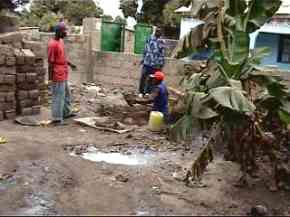 |
|
soil is mixed with water in a hole
in the ground, and shovelled onto a sheet |
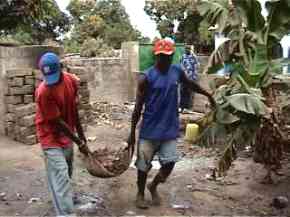 |
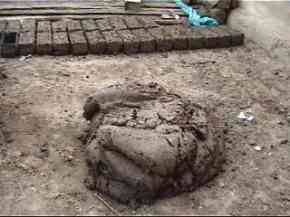 |
|
a load of mud is carried from the hole and
dumped on a pile near to the block making area |
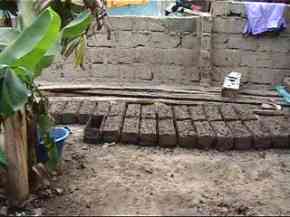 |
 |
mud blocks made previously, with an empty
mould box on the left of the last row |
a quantity
of mud is gathered and shaped
by rolling on the ground |
 |
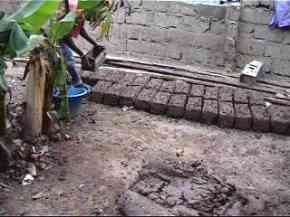 |
the mud is placed into the mould box
patted down and levelled |
the mould
box is lifted up, leaving a new block,
and placed ready for the next one |
|